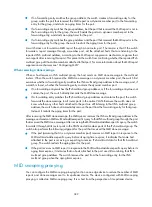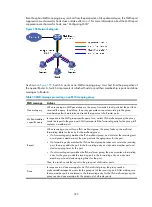
389
•
If no forwarding entry matches the group address, the switch creates a forwarding entry for the
group, adds the port that received the MLD report as a dynamic member port to the forwarding
entry for the group, and starts an aging timer for the port.
•
If a forwarding entry matches the group address, but the port that received the MLD report is not in
the forwarding entry for the group, the switch adds the port as a dynamic member port to the
forwarding entry, and starts an aging timer for the port.
•
If a forwarding entry matches the group address and the port that received the MLD report is in the
forwarding entry for the group, the switch restarts the aging timer for the port.
A switch does not forward an MLD report through a non-router port. The reason is that if the switch
forwards a report message through a member port, all the attached hosts that are listening to the
reported IPv6 multicast address, according to the MLD report suppression mechanism, suppress their
own reports after receiving this report. This prevents the switch from confirming whether the reported IPv6
multicast group still has active members attached to that port. For more information about the MLD report
suppression mechanism, see "Configuring MLD."
When receiving a done message
When a host leaves an IPv6 multicast group, the host sends an MLD done message to the multicast
routers. When the switch receives the MLD done message on a dynamic member port, the switch first
examines whether a forwarding entry matches the IPv6 multicast group address in the message, and, if
a match is found, whether the forwarding entry contains the dynamic member port.
•
If no forwarding entry matches the IPv6 multicast group address, or if the forwarding entry does not
contain the port, the switch directly discards the MLD done message.
•
If a forwarding entry matches the IPv6 multicast group address and contains the port, the switch
forwards the done message to all router ports in the native VLAN. Because the switch does not
know whether any other hosts attached to the port are still listening to that IPv6 multicast group
address, the switch does not immediately remove the port from the forwarding entry for that group.
Instead, it restarts the aging timer for the port.
After receiving the MLD done message, the MLD querier resolves the IPv6 multicast group address in the
message and sends an MLD multicast-address-specific query to that IPv6 multicast group through the port
that received the MLD done message. After receiving the MLD multicast-address-specific query, the switch
forwards it through all its router ports in the VLAN and all member ports of the IPv6 multicast group. The
switch also performs the following judgment for the port that received the MLD done message:
•
If the port (assuming that it is a dynamic member port) receives an MLD report in response to the
MLD multicast-address-specific query before its aging timer expires, it indicates that some host
attached to the port is receiving or expecting to receive IPv6 multicast data for that IPv6 multicast
group. The switch restarts the aging timer for the port.
•
If the port receives no MLD report in response to the MLD multicast-address-specific query before its
aging timer expires, it indicates that no hosts attached to the port are still monitoring that IPv6
multicast group address. The switch removes the port from the forwarding entry for the IPv6
multicast group when the aging timer expires.
MLD snooping proxying
You can configure the MLD snooping proxying function on an edge device to reduce the number of MLD
reports and done messages sent to its upstream device. The device configured with MLD snooping
proxying is called an MLD snooping proxy. It is a host from the perspective of its upstream device.
















































